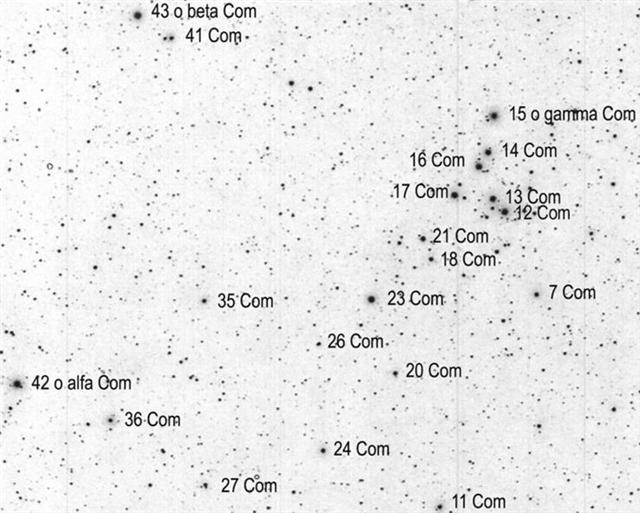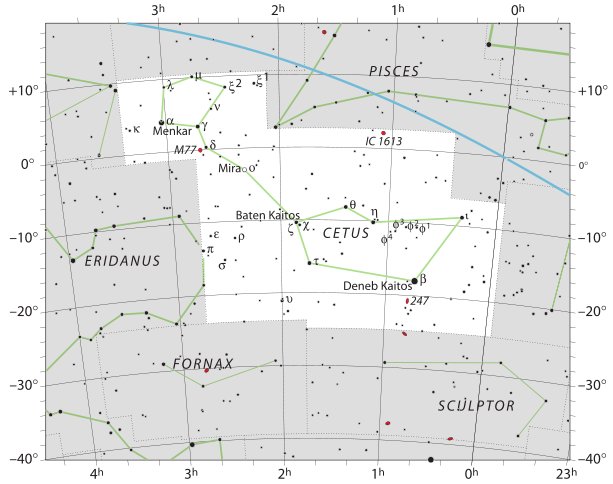|
5. Allen:
"Hyde cited
some ancient codices as applying to Fl. 21, toward the south, the
title Kissīn, a species
of ivy, Convolvulus, or perhaps the climbing Dog-rose.
This appeared in Ulu Beg,
evidently from Ptolemy's κίσσινος, but Ideler said that it was
intended to mark c, g, and h, and Baily, that is was for Fl. 21 or
23.
There evidently is much
uncertainty as to the lettering and numbering of Coma's stars; and it
seem remarkable that such minute objects should bear individual
names.
Near Fl. 6 is the Pin-wheel
Nebula, N.G.C. 4254, 99 M, one of the pyrotechnics of the sky; while
Fl. 31 closely marks the pole of the Milky Way, more exactly in
right ascension 12º 40' and north distance 28º; the southern pole
lying in Cetus."

| Fl. 6 |
12h 16m 00.23s |
12h 16.004m |
186.2 |
| Fl. 21 |
12h 31m 00.57s |
12h 31.010m |
190.0 |
| Fl. 31 |
12h 51m 41.93s |
12h 51.699m |
195.3 |
| Diadem |
13h 09m 59.55s |
13h 09.993m |
199.9 |

|
13th hour: |
| |
ο Virginis |
4.12 |
08° 44′ N |
12h 02m |
183.1 |
591.1 |
| Alchita |
α Corvi |
4.02 |
24° 27′ S |
12h 06m |
184.1 |
592.1 |
| Minkar |
ε Corvi |
3.02 |
22° 20′ S |
12h 08m |
184.7 |
592.7 |
| Pálida |
δ Crucis |
2.79 |
58° 45′ S |
12h 12m |
185.6 |
593.6 |
| Megrez |
δ Ursa Majoris |
3.32 |
57° 19′ N |
12h 13m |
185.9 |
593.9 |
| Gienah |
γ Corvi |
−0.94 |
22° 37′ S |
12h 14m |
186.1 |
594.1 |
|
|
6 Com. Berenicis |
5.09 |
14° 54′ N |
12h 14m |
186.2 |
594.2 |
| |
ε Muscae |
4.06 |
67° 58′ S |
| Zaniah |
η Virginis |
3.89 |
00° 40′ S |
12h 16m |
186.8 |
594.8 |
| Chang Sha |
ζ Corvi |
5.20 |
22° 13′ S |
12h 18m |
187.3 |
595.3 |
| Intrometida |
ε Crucis |
3.59 |
60° 24′ S |
12h 23m |
188.4 |
596.4 |
| Acrux |
α Crucis |
1.40 |
62° 49′ S |
12h 23m |
188.5 |
596.5 |
| |
γ Com. Berenicis |
4.35 |
28° 16′ N |
12h 25m |
189.0 |
597.0 |
| Algorab |
δ Corvi |
2.94 |
16° 14′ S |
12h 27m |
189.5 |
597.5 |
| Gacrux |
γ Crucis |
1.59 |
57° 07′ S |
12h 28m |
189.7 |
597.7 |
|
Kissin |
21 Com. Berenicis |
5.47 |
24° 34′ N |
12h 29m |
190.0 |
598.0 |
| |
γ Muscae |
3.84 |
72° 08′ S |
| Avis Satyra |
η Corvi |
4.30 |
16° 12′ S |
12h 30m |
190.3 |
598.3 |
| Asterion |
β Canum Venaticorum |
4.24 |
41° 38′ N |
12h 31m |
190.5 |
598.5 |
| Kraz |
β Corvi |
2.65 |
23° 07′ S |
12h 32m |
190.7 |
598.7 |
| |
α Muscae |
2.69 |
69° 08′ S |
12h 34m |
191.2 |
599.2 |
| |
χ Virginis |
4.66 |
07° 60′ S |
12h 36m |
191.7 |
599.7 |
| |
ρ Virginis |
4.88 |
10° 14′ N |
12h 39m |
192.4 |
600.4 |
| Porrima |
γ Virginis |
2.74 |
01° 11′ S |
12h 39m |
192.5 |
600.5 |
| |
β Muscae |
3.04 |
68° 06′ S |
12h 43m |
193.5 |
601.5 |
| Mimosa |
β Crucis |
1.25 |
59° 41′ S |
12h 44m |
193.9 |
601.9 |
| |
31 Com. Berenicis |
4.93 |
27° 32′ N |
12h 50m |
195.3 |
603.3 |
| |
ψ Virginis |
4.77 |
09° 32′ S |
12h 51m |
195.5 |
603.5 |
| Alioth |
ε Ursa Majoris |
1.76 |
56° 14′ N |
12h 52m |
195.8 |
603.8 |
| Minelauva |
δ Virginis |
3.39 |
03° 40′ N |
12h 53m |
196.1 |
604.1 |
| Cor Caroli |
α Canum Venaticorum |
2.89 |
38° 35′ N |
12h 54m |
196.3 |
604.3 |
| |
δ Muscae |
3.61 |
71° 33′ S |
12h 59m |
197.5 |
605.5 |
 |
 |
 |
 |
 |
|
Ga5-10
(121) |
Ga5-11 (*186) |
Ga5-12 |
Ga5-13 |
Ga5-14 |
|
Minkar
(184.7) |
Pálida (185.6), Megrez
(185.9), Gienah (186.1),
6 Com.
Ber.,
ε Muscae (186.2) |
Zaniah
(186.8), Chang Sha (187.3) |
Intrometida (188.4) |
Acrux
(188.5),
γ Com.
Berenicis (189.0) |
|
September 22 |
23 (266) |
24 |
25 |
26 |
 |
 |
 |
 |
|
Ga5-15 |
Ga5-16
(**99) |
Ga5-17
(*192) |
Ga5-18 |
|
Algorab
(189.5), Gacrux (189.7),
Kissin,
γ Muscae (190.0), Avis Satyra (190.3) |
Asterion
(190.5), Kraz (190.7), α Muscae (191.2) |
χ
Virginis (191.7), ρ Virginis (192.4), Porrima
(192.5) |
β Muscae (193.5) |
|
27 (270) |
28 |
29 |
30 |
 |
 |
 |
 |
 |
|
Ga5-19 (130) |
Ga5-20 |
Ga5-21
(*196) |
Ga5-22 |
Ga5-23 |
|
Mimosa
(193.9) |
|
31 Com. Ber.
(195.3),
ψ Virginis (195.5), Alioth (195.8), Minelauva (196.1),
Cor Caroli (196.3) |
|
δ Muscae
(197.5) |
|
October 1
(274) |
2 |
3 |
4 |
13h = 197.8 |
Supposing Fl. 31 at Ga5-21 indicates the northern pole of
the Milky Way, then we should be able to find the other end of
the pole by counting. And it ought to be in Cetus.
12º
40' * 365¼ / 360º = day 12.85 counted from March 21 means April
3 (93).
Right ascension 12h 50m
corresponds to day 196 counted from March 21 = October 3
(276).
276 - 93 = 183.
Right ascension 12h 50m +
12h = 00h 50m corresponds to day 13 counted from March 21, i.e.
April 3 (93):
 |
 |
 |
 |
| Gb6-25 |
Gb6-26 (*1) |
Gb6-27 |
Gb6-28 |
| |
|
Caph, Sirrah (409.5) |
Algenib Pegasi (410.8) |
|
0h (408.0) |
March 22 |
23 |
24 |
 |
 |
 |
 |
|
Gb7-1 |
Gb7-2
(413) |
Gb7-3
(*6) |
Gb7-4 |
|
25 |
26 |
27 |
28 |
 |
 |
 |
 |
 |
 |
 |
| Gb7-5 |
Gb7-6 |
Gb7-7 |
Gb7-8 |
Gb7-9 (420) |
Gb7-10 (*13) |
Gb7-11 |
| |
Delta (417.4) |
Schedir (417.6), Deneb Kaitos (418.4) |
|
Achird (419.7) |
Cih (421.4) |
|
| 29 |
30 |
31 (90) |
April 1 |
2 |
3 |
4 |
However, Cih (from Chinese
Tsih for whip) is not in Cetus but in the center
of Cassiopeia.
... The fundamental idea of the constellation
ought to have been its tendency to turn upside down:
... It is also
known as the Celestial W when below the pole, and the
Celestial M when above it ...
...
There is a kind of
jellyfish named Cassiopea - certainly I think, because of its
habit of being upside down.
It is also named 'Upside Down
Jellyfish':

In Cetus (another sea creature) we have not listed all its major
stars. The first in our list is Deneb Kaitos at right
ascension 00h 41m, although the
unlisted ι comes earlier:

But the position we are looking for is not
earlier than Deneb Kaitos but later (00h 50m
> 00h 41m).
"Although an old
constellation, Cetus is by no means of special interest, except
as possessing the south pole of the Milky Way and the Wonderful
Star, the variable Mira; and from the fact that it is a
condensation point of nebulae [marked with φ in the map above]
directly across the sphere from Virgo, also noted in this
respect." (Allen)
 |
 |
 |
 |
 |
| Gb8-1 |
Gb8-2 (444) |
Gb8-3 |
Gb8-4 |
Gb8-5 (**419) |
| Mira (442.7) |
|
|
|
|
| April 25 |
26 (116) |
27 |
28 |
29 |
|












